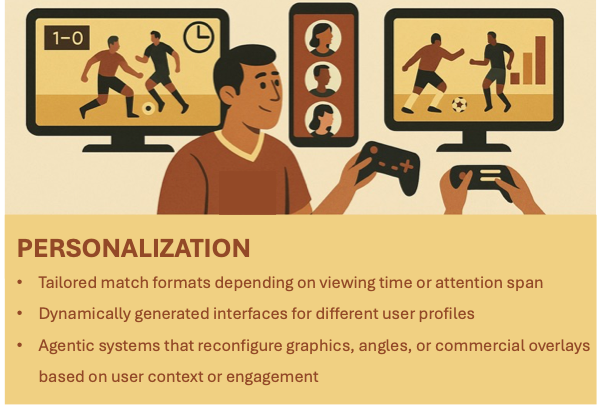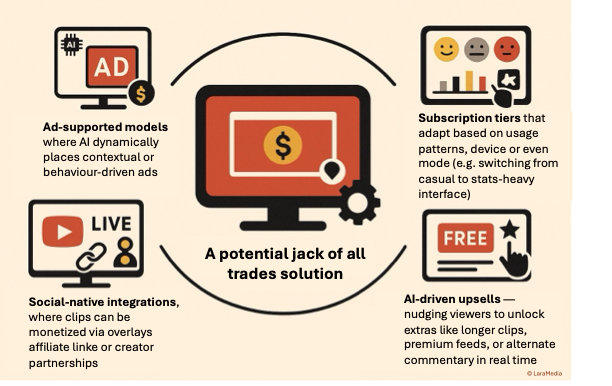Part 3 – Vendors at the Crossroads: Enablers of the Future of Sports Broadcasting
In the first two parts of this series on the Future of Sports Broadcasting I explored the possible futures of European sports broadcasting — from consolidation and hybrid models to direct-to-consumer platforms, fragmentation, and regulation. But while broadcasters and federations dominate the headlines, there’s another group whose role is equally decisive: the vendors.
Technology providers, production companies, and service providers are the ones who must make every scenario technically and operationally viable, while providing financially compelling solutions. The challenge is that vendors must often anticipate change faster than their clients. After many great conversations at IBC 2025 it became clear, that while broadcasters and federations were still debating future strategies, vendors were already showcasing the software-tools, interoperable solutions, and modular workflows that will enable whatever direction the industry takes.
1. Future-proof tech that works across all potential future models
The shift to software-defined, modular infrastructures is no longer a choice but an inevitability. Vendors today must deliver elastic systems that can seamlessly scale up for global mega-events and scale down for pop-up feeds or niche productions. It will be crucial to design those systems with the future workforce in mind — not the classic broadcast engineer, but developers and technically savvy content creators.
At IBC 2025, the mood was strikingly pragmatic. Cloud is no longer discussed as a shiny experiment but as a practical tool — but also one increasingly shaped by cost pressures, US-centricity and the need for sovereign solutions. The consensus was clear: the future lies in software that can run in private data centers and hyperscalers alike.
On top of that, interoperability and fast integration cycles are critical. That's why I find the EBU’s work on Dynamic Media Facilities and MXL particularly exciting. MXL is not a proprietary standard — it’s an open-source SDK, designed for real-time, in-memory sharing of video, audio, and metadata across systems. It enables cross-vendor agility, and helps dismantle siloed workflows. I can't wait for the first release end of this year!
If you want to dive deeper, I recommend watching the EBU DMF Meetup from IBC 2025.
2. Fan-Centric Creativity with AI
AI at IBC showed real world appliations and great agentic AI projects that promise to be shape the future of sports. But for vendors, the true opportunity lies far beyond automation and producing more with less. Yes, efficiency gains are real: automated highlight generation, metadata tagging, subtitling, and real-time translation are already saving time and money across the chain. But that’s just the starting point.
What comes next will define the role of vendors in the years ahead: a shift from efficiency tools to systems that drive fan-centric creativity.
We're entering an era where AI isn't just supporting production — it’s shaping the fan experience itself. Picture AI-curated highlight reels based on your favourite team or player, emotion-aware graphics that reflect the crowd’s mood, or alternate commentary streams for Gen Z creators.
This isn’t just wishful thinking — it’s already emerging across direct-to-consumer (D2C) and hybrid models, where AI is being used to dynamically adapt feeds, surfaces, and monetisation strategies to different audiences. For example, a casual viewer might receive short, mobile-first clips, while a hardcore fan gets a tactical breakdown stream or multi-angle replay system. In a Public Value Rebound scenario, AI also plays a critical role — enabling auto-captioning, multilingual support, and adaptive UI features that ensure accessibility across demographics and devices.
But beyond features, there’s one theme that now cuts across all strategies: personalization. And this is where vendors have the potential to make a real difference and help to serve every viewer from the casual Saturday Night sports family, the hard-core fans and the short-form and meme GenZ and Alpha viewers.
In his recent article Agentic AI Development in Media Tech, Lorenzo Zanni highlights a critical shift: we’re moving from tools that automate discrete tasks to agents that operate proactively, learning from audience behavior and continuously adapting experiences. This has the possibility to change the game entirely.
The vendor’s role in this isn’t just to provide tools — it is to architect intelligent systems that balance operational efficiency with deep, context-aware creativity. In a world of splintered rights and soaring expectations, personalization isn’t just a feature. It’s the future.
3. The Money Is Where the Eyeball Is — and It Needs to Be Monetized
At the core of every future scenario in sports broadcasting — whether it’s consolidation, fragmentation, or a hybrid models — one truth remains: the money is where the eyeball is.
And eyeballs are no longer confined to one screen, one format, or one business model.
For vendors, this means becoming the enabler of monetization everywhere. Whether fans are watching full matches on TV, catching snackable moments on YouTube, or engaging with creator-led TikTok content — vendors who can provide the solutions and intelligence to monetize across all of those touchpoints will become indispensable partners.
This is where agentic AI might become a true game-changer. We're no longer talking about static paywalls or one-size-fits-all pricing. We’re talking about personalized monetization logic — where the system intelligently decides when and how to present offers, based on audience behavior, content context, and strategic revenue goals.
In a fragmented Wild West scenario, this might mean bundling highlights from multiple leagues into a dynamic micro-subscription package. In a D2C-driven world, federations could use AI to segment their audience and upsell VIP streams, second-screen apps, or gamified overlays. In public-value-focused models, monetization may come from adjacent content or interactive experiences around free-to-air matches — rather than the games themselves.
Ultimately, the rights holder may decide what to charge for — but it’s the vendor who shall make it possible to charge smartly, wherever the fan's eyeballs are.
From Scenarios to Action
Over the course of this series, I've looked at five possible futures for sports broadcasting — and unpacked what they mean for federations, broadcasters, and vendors.
From the rise of platform giants to the possibility of a public-value rebound, one thing is clear: this industry is on the move.
Legacy models are being re-evaluated. Fan expectations are evolving. And the cost of doing nothing is rising.


